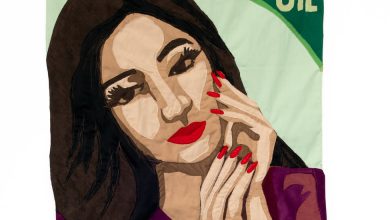Watergate Salad Makes a Comeback

At an office Thanksgiving potluck in Dallas last month, employees showed off their home cooking (and their catered shortcuts): There was spicy mac and cheese and roasted brussels sprouts, candied bacon and gumbo.
Then, a woman held up a vat of mint-green fluff in a pan. Behold: The Watergate Salad.
“It’s just a staple of our Thanksgiving,” said Kelly McDuff, 26, who brought the dish. “So I thought it was a staple at everybody’s.”
“And then,” she said, “I realized it wasn’t.”
Few of her colleagues had tried Watergate salad, an ambrosia-adjacent dish usually made with pistachio pudding mix, Cool Whip, pecans, mini marshmallows and canned, crushed pineapple. (Some also include maraschino cherries or coconut.) They were curious — amused even.
And eventually millions of others were, too. After Ms. McDuff posted a TikTok video of the potluck, the salad is having a renaissance online. Her video has been viewed more than 18 million times.
And it’s having a ripple effect: While interest in Watergate salad tends to peak around Thanksgiving — last November, there were about 200,000 Google searches for the term — this year those queries nearly doubled.
It’s a perfect storm of internet virality: There’s the appeal of holiday nostalgia for those in the know, and then there’s the morbid curiosity of the uninitiated.
After seeing the salad on TikTok, Tara Candelario, 34, made it for her in-laws, who are not from the United States. “They said it ‘wasn’t bad,’ but I mean, they went back for thirds,” she said. And they kept the leftovers.
Much of the intrigue surrounding Watergate salad lies in the fact that it’s categorized as a salad at all.
“This is the only country in the world where you can actually sometimes not distinguish between the dessert and the salad,” said Laura Shapiro, a food historian.
The dish is cloyingly sweet, but it is not a dessert. Families across the American South and Midwest often make it for holiday meals, to eat alongside savory centerpieces like ham and turkey.
“It’s a complete side,” said Lana Allen, 54, a salon owner in Texas whose husband’s family makes it regularly. “So you’ll just eat it just like if you were going to have corn,” she added.
This is not the first midcentury, middle-America food craze to find new life online: Jell-O molds, 1970s-era desserts and 1970s-themed dinner parties have all made unexpected comebacks.
That’s all “packaged-food cuisine” born of the hyper-consumerism of the 1950s, Ms. Shapiro said. For some, the box mixes and cans — triumphs of postwar prosperity — are a rosy portal to an imagined “simpler time” of family dinners and easy living.
“That is nostalgia for America,” she said. “That is our national comfort food.”
There are two prevailing theories about the salad’s origin — and the provenance of its name.
The first is that it was created by a chef at the Watergate Hotel. But Ali Le, the marketing director of the hotel in the infamous Washington, D.C., building, said she looked into it, and that’s not the case.
The second is that the name is a coincidence of history.
The salad became popular around the time of the eponymous scandal, which started with the June 17, 1972 break-in and ended with the resignation of President Richard Nixon more than two years later. (Notably, his resignation lunch included pineapple.)
Journalists began writing about the salad at least as early as 1973: “Watergate Salad is said to be catching on,” reads an article from The Miami News. It really caught on a few years later, in 1976, and became an enduring legacy of the disgraced leader.
“It’s sort of like naming a salad after Jan. 6,” Ms. Shapiro said. “Like, Trump tries to take over the capitol, and you name a salad after that.”
The salad may have been concocted not by a restaurant chef or even home cooks, but by the brands behind the packaged goods used to make it. Food companies often invented recipes to sell a product like pistachio pudding mix or marshmallows. But Kraft Heinz, which owns Jell-O, did not respond to multiple requests for comment.
“It definitely has the air of something created in a test kitchen,” Ms. Shapiro said. “The products are so incongruous. They just don’t belong together.”
But that incongruity has been critical to its success online.
“It doesn’t look edible,” said Alex Duncan IV, 37, who learned about it on TikTok. “But, I’m like, OK. A lot of people are eating it, you know? I think when I first saw it, it’s definitely one of those icks mixed with intrigue.”
Donnie Mays, 33, was reminded of the salad by a TikTok video. He then posted a recipe for it, inspired by his Aunt Penny. (This is her specialty, he said. Otherwise, Aunt Penny doesn’t really cook.)
“It takes me back,” he said, adding, “It doesn’t look that appealing, but once you get into it, it just is the most delicious thing ever.”
That powerful nostalgia doesn’t surprise Ms. Shapiro, the food historian. She has found recipes for Watergate salad, or a similar Watergate cake, in community cookbooks from New Jersey, Mississippi and North Dakota. Many are from the early 2000s, a generation after the salad’s debut.
That shows her its geographic spread — and its staying power.
“This is American cooking,” she said. “It just is. Nothing is more authentic than this.”
Kitty Bennett and Eleanore Park contributed research.
Follow New York Times Cooking on Instagram, Facebook, YouTube, TikTok and Pinterest. Get regular updates from New York Times Cooking, with recipe suggestions, cooking tips and shopping advice.





